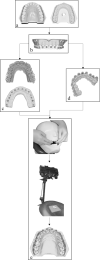Bracket transfer accuracy with two different three-dimensional printed transfer trays vs silicone transfer trays
- PMID: 34982114
- PMCID: PMC9020396
- DOI: 10.2319/040821-283.1
Bracket transfer accuracy with two different three-dimensional printed transfer trays vs silicone transfer trays
Abstract
Objectives: To compare the transfer accuracy of two different three-dimensional printed trays (Dreve FotoDent ITB [Dreve Dentamid, Unna, Germany] and NextDent Ortho ITB [NextDent, Soesterberg, the Netherlands]) to polyvinyl siloxane (PVS) trays for indirect bonding.
Materials and methods: A total of 10 dental models were constructed for each investigated material. Virtual bracket placement was performed on a scanned dental model using OnyxCeph (OnyxCeph 3D Lab, Chemnitz, Germany). Three-dimensional printed transfer trays using a digital light processing system three-dimensional printer and silicone transfer trays were produced. Bracket positions were scanned after the indirect bonding procedure. Linear and angular transfer errors were measured. Significant differences between mean transfer errors and frequency of clinically acceptable errors (<0.25 mm/1°) were analyzed using the Kruskal-Wallis and χ2 tests, respectively.
Results: All trays showed comparable accuracy of bracket placement. NextDent exhibited a significantly higher frequency of rotational error within the limit of 1° (P = .01) compared with the PVS tray. Although PVS showed significant differences between the tooth groups in all linear dimensions, Dreve exhibited a significant difference in the buccolingual direction only. All groups showed a similar distribution of directional bias.
Conclusions: Three-dimensional printed trays achieved comparable results with the PVS trays in terms of bracket positioning accuracy. NextDent appears to be inferior compared with PVS regarding the frequency of clinically acceptable errors, whereas Dreve was found to be equal. The influence of tooth groups on the accuracy of bracket positioning may be reduced by using an appropriate three-dimensional printed transfer tray (Dreve).
Keywords: 3D printing; Indirect bonding; Transfer accuracy; Virtual bracket placement.
© 2022 by The EH Angle Education and Research Foundation, Inc.
Figures




References
-
- Gange P. The evolution of bonding in orthodontics. Am J Orthod Dentofacial Orthop . 2015;147(4):56–63. - PubMed
-
- Guenthner TA, Larson BE. Indirect bonding: a technique for precision and efficiency. Semin Orthod . 2007;13(1):58–63.
-
- Kalange JT. Indirect bonding: a comprehensive review of the advantages. World J Orthod . 2004;5(4):301–307. - PubMed
-
- Keim RG, Gottlieb EL, Vogels DS, Vogels PB. 2014 JCO study of orthodontic diagnosis and treatment procedures, part 1: results and trends. J Clin Orthod . 2014;48(10):607–630. - PubMed
MeSH terms
Substances
LinkOut - more resources
Full Text Sources
Research Materials
Miscellaneous

